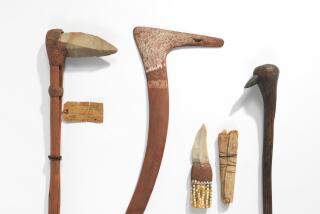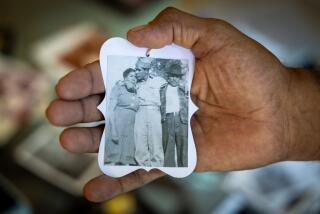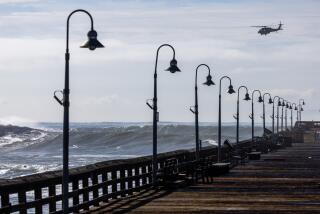They Came, They Saw, They Dug
It was 1973, and urban renewal was in full swing. So it made perfect sense to tear down the muffler shop next to the mission in downtown Ventura and replace it with 11 new homes.
But as workers began digging up the shop’s asphalt parking lot, history emerged -- in the form of Spanish crucifixes, Chumash beads, Chinese pottery and two stone bowls dating back to 1600 BC.
Instead of new homes, the Albinger Archaeological Museum was opened two years later on the 1 1/2-acre site to showcase the artifacts found there and to illuminate the multicultural roots of the seaside city.
“This dig wrote new history for the city of Ventura,” said Richard Senate, a longtime city employee and the town’s unofficial historian.
This weekend, a small group of archeologists and students who participated in the excavation during the summers of 1974 and 1975 will gather to reminisce about their discoveries.
Roberta Greenwood, an archeologist who lives and works in Pacific Palisades, was hired to oversee the dig, adjacent to the mission parking lot.
She quickly realized that she had uncovered a treasure trove.
“So much was preserved, practically at ground level,” said Greenwood, who will be the guest of honor at Saturday’s reunion. “To find so much in good condition and fairly intact was a real discovery and a great pleasure.”
According to a written history of the Albinger, the project took form in 1973, when volunteers with the Ventura County Archaeological Society discovered that historical deposits were being destroyed by a bulldozer slicing through the muffler shop’s parking lot.
The head of the group, Robert O. Browne, went to City Hall, and demolition was halted.
In September 1974, the city voted to buy the land back.
The museum, located near the west end of Main Street, was opened as the Archaeological Interpretive Center in 1975; in 1982, it was renamed for former Mayor Albert Albinger, who was instrumental in the city’s downtown redevelopment.
Senate and Greenwood praised the city’s fast action -- first in stopping construction, then in setting up the dig and finally in opening the museum.
“It was very gutsy for the city to even build the museum back in the ‘70s,” Senate said. “It was the first archeological museum of its kind in the nation. It has served as a template for museums ... all over the country.”
What makes it special, Senate said, is that “all the things dug up there are still on site. It’s as close as you can come to visiting a real dig.”
Greenwood also cited the support of City Hall -- and the camaraderie.
Not long into the job, “the effete bureaucrats challenged the strong, brown, tanned archeologists to weekly volleyball games,” Greenwood said.
Who won? “I don’t want to boast too much,” she said, laughing. Most of the crew of about 30 had known each other before the job began and have remained friends over the years, Greenwood said. More than a dozen are expected to show up for the reunion.
During the digs, the workers even lived together. The first summer, the crew took over the soon-to-be-demolished Cecil hotel on Ventura Avenue. The second summer, the archeologists lived in a motel on Thompson Boulevard.
They played together, too. Pictures from the dig show bare-chested men cavorting in “Lake Valdez,” the mud pit formed near Valdez Alley by the runoff of water used to wash the artifacts.
Among the discoveries at the site were the foundations of four residences and what is believed to be an earlier, abandoned mission. The existing San Buenaventura Mission was built in 1782.
“We knew the foundations were there,” Greenwood said. “For the first couple of weeks they just kept growing and growing and growing as we uncovered them.”
Today, their outlines offer visitors a glimpse of where the Chumash neophytes -- those who had been converted to Christianity -- lived. The residences housed “middle managers,” who helped keep their fellow Indians in line for the Spanish, Senate said.
The small homes had porches, walls and doors, Senate said, and one had an indoor oven.
Nearby is a water well and beyond that, a 2,300-year-old oven.
The building that housed the muffler shop still stands, but it has been stuccoed and rewired, transformed into a graceful museum, where about a quarter of the thousands of artifacts found on the site are displayed. The rest are stored in the Ventura County Museum of History & Art across the street.
Exhibits highlight periods ranging from pre-Chumash (1600-100 BC) through the 20th century.
Among the artifacts are beads, pestles and soapstone griddles from the Chumash era (1500-1834); crucifixes and roof tiles from the Spanish period (1782-1822); and glass and pottery from the Mexican period (1822-1847).
Greenwood counts whistles found on the site among the most interesting objects. The whistles, made from the bones of deer, were stolen from the archeologists’ lab during the dig and turned up later in the mission, smashed to pieces.
Pieced back together, they are on view in the Chumash display.
Nearby are a dozen or so crucifixes found in the residences.
In another case is the “modern” display, which includes the porcelain head of a doll, an 1890 toothbrush made of ivory with hog bristles, and the remnants of Army boots, circa 1872.
There are also coins and pottery from Ventura’s Chinatown, which existed in the early 20th century.
Museum manager Jeanne Scott hopes the reunion casts light on the institution. The Albinger is owned by the city of Ventura, and the history museum is operated by a nonprofit group.
“Last year, we had 10,000 people through,” Scott said, most of them students. “Most of the kids have seen it, but the parents haven’t.”
Senate, who helped develop the Albinger’s educational programs, likes to tell visitors that “the missions were not just a church. They were more like little communes.”
They are also monuments to the Native Americans who built them, he said.
“The blood, sweat and tears of that mission are Chumash blood, sweat and tears.”
*
The museum, at 113 E. Main St., is open from 10 a.m. to 2 p.m. Wednesday through Friday and from 10 a.m. to 4 p.m. Saturday and Sunday. Admission is free. The reunion is not open to the public. For information, 648-5823.
More to Read
Sign up for Essential California
The most important California stories and recommendations in your inbox every morning.
You may occasionally receive promotional content from the Los Angeles Times.









